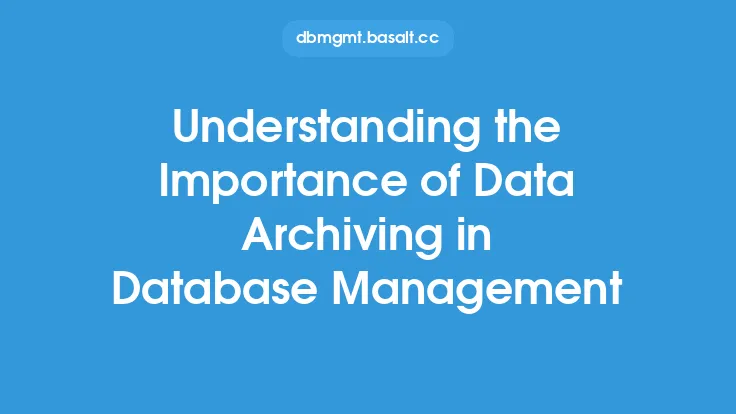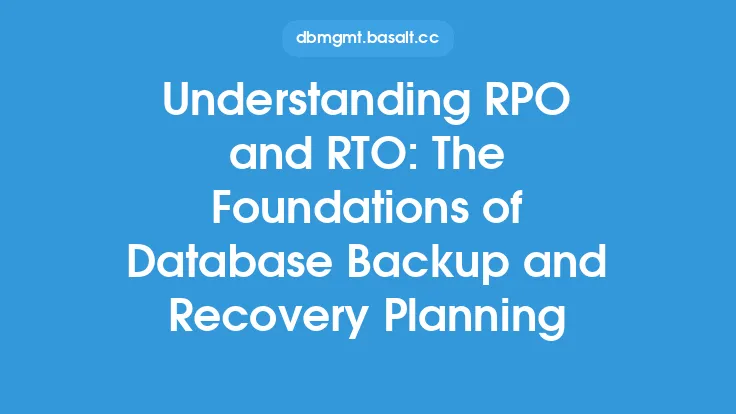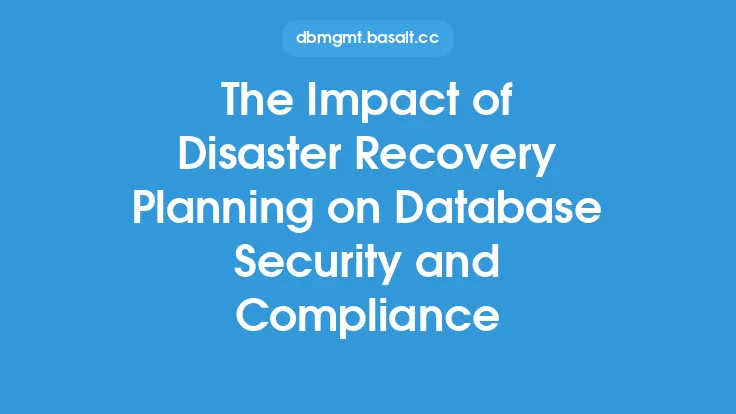Disaster recovery planning is a critical aspect of database management that involves creating and implementing procedures to minimize data loss and ensure business continuity in the event of a disaster. A disaster can be anything from a natural disaster such as a hurricane or earthquake, to a man-made disaster such as a cyber-attack or hardware failure. The goal of disaster recovery planning is to ensure that the database is restored to a functional state as quickly as possible, with minimal data loss and disruption to business operations.
What is Disaster Recovery Planning?
Disaster recovery planning is the process of creating a plan to recover a database after a disaster. This plan should include procedures for backup and recovery, data replication, and system restoration. The plan should also identify the risks and threats to the database, and provide strategies for mitigating those risks. A good disaster recovery plan should be tailored to the specific needs of the organization, and should be regularly reviewed and updated to ensure that it remains effective.
Benefits of Disaster Recovery Planning
There are several benefits to having a disaster recovery plan in place. One of the most significant benefits is the ability to minimize data loss and ensure business continuity. A disaster recovery plan can help to reduce the risk of data loss and corruption, and can ensure that the database is restored to a functional state as quickly as possible. This can help to minimize the impact of a disaster on business operations, and can help to ensure that the organization can continue to operate with minimal disruption.
Another benefit of disaster recovery planning is the ability to reduce downtime and improve system availability. A disaster recovery plan can help to identify the causes of downtime, and can provide strategies for reducing the risk of downtime. This can help to improve system availability, and can ensure that the database is always available when it is needed.
Key Elements of a Disaster Recovery Plan
A disaster recovery plan should include several key elements. One of the most important elements is a backup and recovery strategy. This strategy should include procedures for backing up data, and for recovering data in the event of a disaster. The strategy should also include procedures for testing backups, and for ensuring that backups are complete and accurate.
Another key element of a disaster recovery plan is a data replication strategy. This strategy should include procedures for replicating data to a remote location, and for ensuring that data is synchronized across all locations. The strategy should also include procedures for testing data replication, and for ensuring that data replication is complete and accurate.
Types of Disasters
There are several types of disasters that can affect a database. One of the most common types of disasters is a natural disaster, such as a hurricane or earthquake. These types of disasters can cause physical damage to the database, and can result in data loss and corruption.
Another type of disaster is a man-made disaster, such as a cyber-attack or hardware failure. These types of disasters can cause logical damage to the database, and can result in data loss and corruption.
Impact of Disasters on Databases
Disasters can have a significant impact on databases. One of the most significant impacts is data loss and corruption. Disasters can cause physical or logical damage to the database, resulting in data loss and corruption. This can have a significant impact on business operations, and can result in financial losses and reputational damage.
Another impact of disasters on databases is downtime and system unavailability. Disasters can cause the database to become unavailable, resulting in downtime and system unavailability. This can have a significant impact on business operations, and can result in financial losses and reputational damage.
Best Practices for Disaster Recovery Planning
There are several best practices for disaster recovery planning. One of the most important best practices is to regularly review and update the disaster recovery plan. This can help to ensure that the plan remains effective, and that it is tailored to the specific needs of the organization.
Another best practice is to test the disaster recovery plan regularly. This can help to ensure that the plan is complete and accurate, and that it can be implemented quickly and effectively in the event of a disaster.
Conclusion
In conclusion, disaster recovery planning is a critical aspect of database management that involves creating and implementing procedures to minimize data loss and ensure business continuity in the event of a disaster. A disaster recovery plan should include procedures for backup and recovery, data replication, and system restoration, and should be tailored to the specific needs of the organization. By following best practices for disaster recovery planning, organizations can help to minimize the impact of disasters on their databases, and can ensure that their databases are always available when they are needed.





